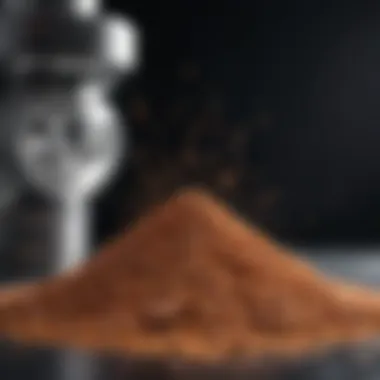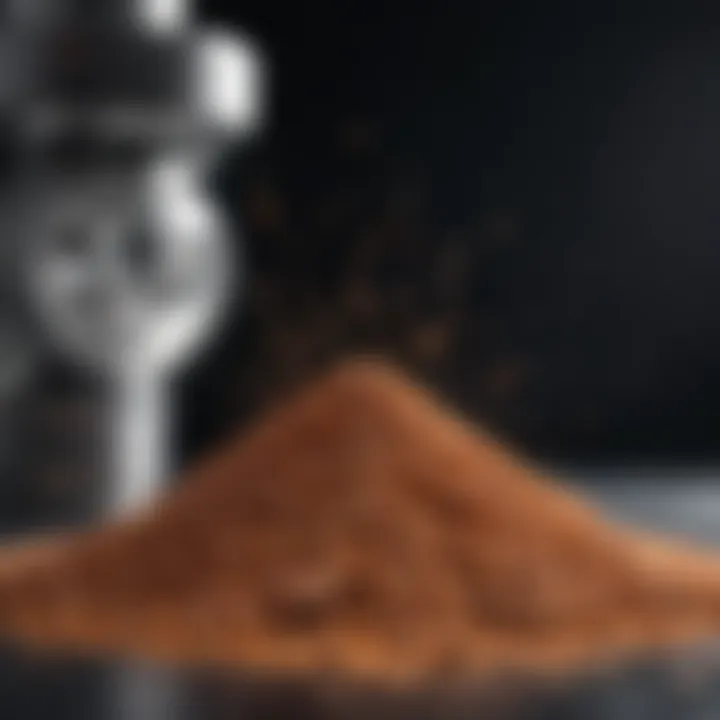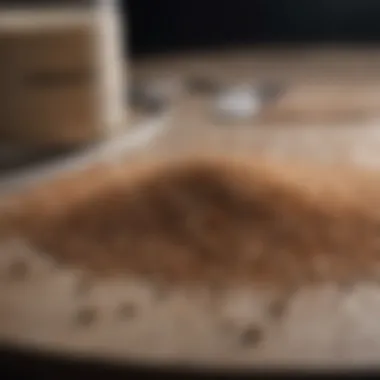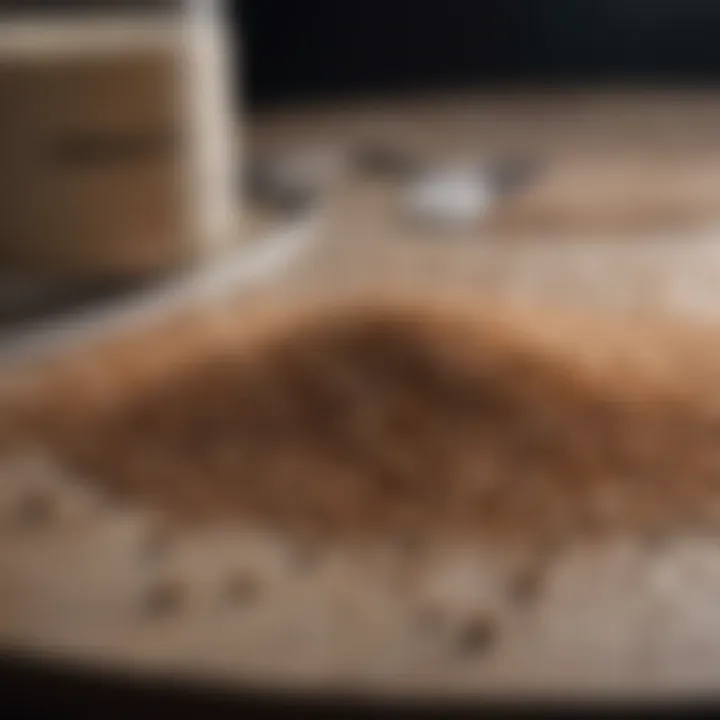Understanding Powder Granulation: Methods and Innovations


Intro
Powder granulation is not just a method; it's an essential bridge between raw materials and useful products across multiple industries. The process fundamentally alters the characteristics of the powders involved, impacting everything from flowability to solubility. It’s a technique that finds its relevance in diverse fields such as pharmaceuticals, agriculture, and food production. This article embarks on a detailed exploration of the granulation process, shedding light on its various methods, applications, and noteworthy advancements made recently.
Each granulation approach brings unique advantages and challenges. Wet granulation, for example, is favored in pharmaceutical applications for its ability to produce uniform particles. Conversely, dry granulation might find more usage in certain types of food production where moisture sensitivity is a concern. This article aims to unpack these complexities, focusing on the relevance of powder granulation in today's innovative landscape.
Research Overview
Summary of Key Findings
Granulation has significantly evolved over the years due to the integration of advanced technologies. Key findings suggest that utilizing novel excipients can lead to enhanced granule properties, positively influencing the overall efficacy and quality of the final product. A thorough analysis reveals three primary granulation methods:
- Wet Granulation: Typically used in pharmaceuticals, involves the addition of a liquid binder to form agglomerates.
- Dry Granulation: A preferred choice when moisture-sensitive formulations are encountered.
- Fluid Bed Granulation: Known for its efficiency, mixing, and drying in one step.
Importance of the Research in its Respective Field
The importance of understanding powder granulation cannot be overstated. As industries push the narrative of efficiency, quality, and cost-effectiveness, the quest for enhanced granulation techniques becomes imperative. Improved granulation affects product performance drastically; in pharmaceuticals, it can mean the difference between an effective drug and a failed formulation. This research serves as a resource, meticulously delving into the nuances of granulation that could better inform practices and innovations in various industries.
Methodology
Description of the Experimental or Analytical Methods Used
In exploring powder granulation, a blend of qualitative and quantitative analyses provides a well-rounded view. Laboratory experiments often entail:
- Granule Size and Distribution Analysis: Using sieve analysis or laser diffraction techniques.
- Flowability Tests: Employing tools such as an avalanche tester to assess the granules' handling properties.
- Moisture Content Assessment: Utilizing Karl Fischer titration or thermogravimetric methods.
Sampling Criteria and Data Collection Techniques
The sampling approach is straightforward but critical. For experimental setups, representative samples from different batches are selected to account for variability. Data collection often involves:
- Field Trials: Conducted in an industrial setting to gather real-world data.
- Laboratory Studies: For obtaining controlled observations regarding the granulation process and resulting product characteristics.
In conducting these investigations, researchers can accurately capture insights that ultimately guide improvements in granulation techniques and applications across various sectors.
Intro to Powder Granulation
Powder granulation is a critical process that bridges the gap between various industries and applications, ranging from pharmaceuticals to food processing, and materials science. Understanding this area not only sheds light on the methods employed but also emphasizes the role it plays in determining product quality and efficacy.
Granulation serves as a method to convert fine powders into a bulk form that is more manageable and functional. Essentially, it's about creating larger granules that can enhance handling, improve flowability, and ensure uniformity in products. It's akin to forming building blocks out of sand; tiny particles alone can be cumbersome and inefficient, but assembled granules lead to greater stability and versatility.
Importance of Understanding Powder Granulation
Being well-versed in powder granulation techniques is invaluable. By mastering these processes, industry professionals can significantly enhance the end products. For instance, in pharmaceuticals, proper granulation can lead to more effective drug delivery systems and improved bioavailability. In the food industry, it can affect texture and shelf life, making it a pivotal part of product development.
Furthermore, advancements in granulation technology can promote sustainability by optimizing resource use and minimizing waste. An understanding of both historical and contemporary methods opens doors for innovations that can redefine industry standards and practices.
As we delve deeper, the nuances of granulation will become evident, revealing how various approaches can impact efficacy and quality, and offering insight into future applications and advancements in technology.
Fundamentals of Granulation Processes
The fundamentals of granulation processes form the backbone of effective powder technology across industries. Understanding these principles is like having the blueprint to a finely tuned machine—each element plays a critical role in ensuring that the final product meets the required specifications. Granulation is not just about making powder into granules; it significantly improves product flow, enhances solubility, and increases compaction properties.
Mechanisms of Granulation
Granulation involves several mechanisms that come into play during the formation of granules. At its core, it is a physical process that transforms fine powders into larger, agglomerated particles. These mechanisms can be broadly categorized into four stages:
- Nucleation: This is the initial stage where small particles come together to form a nucleus. Factors like moisture content and binder presence are crucial in this stage.
- Growth: Once a nucleus is formed, more particles begin to adhere to it, leading to larger granules. This process is affected by parameters such as the mixing speed and the binder solution's viscosity.
- Agglomeration: Here, granules may collide and stick together, forming yet larger aggregates. The conditions of the environment, such as humidity and temperature, can significantly influence the efficiency of this step.
- Sintering: This is where granules are subjected to heat and pressure, which creates inter-particle bonding, enhancing mechanical strength and physical integrity.
This sequential process is highly sensitive, and any misstep can lead to undesirable granule properties. Consequently, understanding these mechanisms can help in tailoring the granulation process for specific applications, optimizing both performance and quality.
Factors Influencing Granulation


Several factors can influence the overall granulation process, and recognizing these can guide improvements in both product and method. Key considerations include:
- Material Properties: Characteristics like particle size, shape, and density can substantially affect granulation effectiveness. For instance, coarser powders may require modifications in approach to achieve the desired granule size.
- Binder Selection: Different binders impart unique properties to the granule. Using a binder that complements the active ingredient can enhance cohesion and flowability.
- Granulation Technique: The choice between wet and dry granulation distinctly alters outcomes. Wet granulation tends to produce finer granules, while dry granulation often results in larger, more robust granules.
- Environmental Conditions: Humidity and temperature can greatly affect the behavior of the materials during granulation. A controlled environment often leads to more consistent results.
- Equipment Parameters: The choice of machinery and its settings (e.g., speed, time) also play a vital role in the granulation outcome.
By considering these factors, professionals in the field can manipulate the processes and materials to achieve optimal results in granule production. Understanding the fundamental principles of granulation processes is not merely academic; it has practical implications in various domains, from pharmaceuticals to food production.
"In powder granulation, small changes can lead to big differences in the end product. A meticulous approach is key to success.”
As the landscape of granulation continues to evolve, grasping these fundamentals remains essential for anyone working within these critical sectors.
Methods of Powder Granulation
The methods of powder granulation encapsulate a range of techniques essential for the transformation of fine powders into granules, significantly influencing their flowability, solubility, and overall performance in various applications. Understanding the different approaches helps in tailoring the granulation process to meet specific industry standards, be it in pharmaceuticals, food, or materials science. Each granulation technique boasts unique advantages and may cater to distinct product requirements. Therefore, a focused study on these methods provides invaluable insight for researchers, educators, and professionals
Wet Granulation Techniques
Wet granulation is a widely adopted method that involves the addition of a liquid binder to powder mixtures, facilitating particle agglomeration. This technique excels when it comes to producing granules with desirable density and improved flow characteristics. In a wet granulation process, the following prominent steps are involved:
- Blending Components: Dry powder ingredients are blended together.
- Liquid Addition: A liquid binder is introduced to the mixture, which is a critical phase. The choice of binder can significantly influence the final granule properties.
- Granule Formation: The wet mass is either sieved or subjected to agglomeration techniques, forming granules of the desired size.
- Drying: The formed granules are subsequently dried to reduce moisture content, thus ensuring stability and prolonging shelf life.
Examples of commonly used liquid binders include hydroxypropyl cellulose and polyvinylpyrrolidone, each bringing its benefits and challenges. Wet granulation often results in well-defined granules with high uniformity; however, it demands effective drying methodologies to mitigate the risk of clumping that excess moisture may introduce. Overall, it is particularly useful in pharmaceutical applications, where specific dissolution profiles are crucial.
Dry Granulation Methods
Dry granulation contrasts sharply with its wet counterpart by eliminating liquid addition. This method encourages compaction of powder into larger granules through various mechanical forces. Factors that may come into play include:
- Roller Compaction: The process involves compressing the powder between rollers, forming sheets that are then ground into granules.
- Stirring Granulator: In this iteration, powders are mechanically mixed under high shear, promoting particle interlocking, which assists in forming granules without any liquid.
A notable advantage of dry granulation is its efficiency in dealing with heat-sensitive materials that might degrade upon exposure to moisture. Given that no drying phase is required, this method can lead to lower energy consumption and faster processing times. While it is frequently employed in the pharmaceutical and food industries, key challenges involve achieving uniform granule sizes and ensuring adequate compaction.
Comparison of Granulation Techniques
When evaluating the merits and drawbacks of wet and dry granulation techniques, it becomes evident that each method serves specific needs within respective industries:
- Efficiency: Wet granulation generally requires more time due to the liquid handling and drying phases, while dry methods are often faster due to their elimination of moisture.
- Equipment Needs: Wet granulation can demand more extensive equipment, particularly for mixing and drying. On the other hand, dry granulation may revolve around simpler apparatus.
- Quality of Granules: Wet granulation tends to produce a finer-quality granule, more uniform in size, while dry granulation may exhibit variability.
"Ultimately, the choice of granulation technique should reflect the specific characteristics desired in the final product and take into account the operational parameters of each method.“
Applications in Pharmaceuticals
The relevance of powder granulation in the pharmaceutical field cannot be overstated. This technique directly influences the efficacy, stability, and safety of drug formulations. Granulation not only improves the flowability of powders, making them easier to process, but also enhances their compressibility. These benefits are crucial in the manufacturing of tablets and capsules, where precise dosages must be achieved consistently. With the pharmaceutical industry leaning towards personalized medicine and complex drug formulations, understanding granulation becomes more relevant than ever.
Role of Granulation in Drug Formulation
Granulation serves as a foundational step in drug formulation, transforming fine powders into granules which are more suitable for the manufacturing process. This conversion is vital for achieving appropriate particle size distribution, which directly affects the solubility and bioavailability of the drug.
Moreover, the granulation process can integrate active pharmaceutical ingredients with excipients like fillers and binders to ensure that the end product meets the necessary quality standards. For instance, if a drug is too soluble, granulation allows formulation adjustments to slow down dissolution rates, thus optimizing the drug's performance in the body.
Additionally, the role of granulation in improving the mechanical properties of the tablets is paramount. Granules tend to have superior strength, reducing the risk of breakage during handling. This aspect is particularly important in commercial operations, where product integrity is vital for consumer trust and regulatory compliance.
"Granulation transforms the pharmaceutical landscape by ensuring consistency and quality in drug delivery, reflecting the tireless advance of science in health care."
Quality Control in Pharmaceutical Granulation
Maintaining high quality in pharmaceutical granulation is non-negotiable. Quality control measures are critical in governing the granulation process. This involves monitoring various parameters such as the size of granules, moisture content, and interparticulate bonding.
If any parameter strays outside established thresholds, it can compromise the final product. For example, excessive moisture during granulation can lead to clumping, adversely affecting tablet uniformity or disintegration time.
To avoid such issues, many companies employ sophisticated technologies like in-line monitoring systems, which provide real-time data on granulation parameters. This proactive approach allows for immediate adjustments to be made before batch completion, ensuring that issues are addressed without sacrificing productivity.
In summary, quality control in granulation processes not only safeguards patient well-being but also supports compliance with stringent regulatory standards set forth by authorities such as the FDA. As regulatory bodies focus increasingly on pharmaceutical quality assurance, the importance of meticulous granulation practices has become more pronounced.


Granulation in Food Processing
Granulation plays a significant role in food processing that often goes unnoticed by the average consumer. This technique isn't just about making large chunks; it's about ensuring food products exhibit desired textures, enhance storage life, and maintain quality during handling. Granulation impacts the physical properties of food products, hence improving their overall performance during processing, packaging, and distribution.
Importance of Granulation in Food Products
The importance of granulation in food manufacturing can't be overstated. It affects the texture, flowability, and solubility of food products. When food ingredients are granulated, the resulting granules possess specific size, shape, and surface area, leading to beneficial properties. Here are some reasons why granulation matters in food:
- Improved Consistency: Granulated products often provide consistency in size and texture. Consistent granule size ensures even cooking and baking, essential for products like cookies or bread.
- Enhanced Solubility: Granulation can enhance the solubility of powders, making them easier to dissolve in liquids. For instant beverages, granulation improves how quickly a drink dissolves in water.
- Better Flow Properties: In manufacturing, materials that flow easily are crucial. Granulated food ingredients, like salt or sugar, can reduce clogging in feeders and hoppers.
- Extended Shelf Life: By granulating, moisture absorption is often reduced, minimizing the risk of clumping or spoilage. This increased stability can lead to a longer shelf life, which benefits both manufacturers and consumers.
| Benefits | Description | | Consistency | Ensures uniform texture and flavor. | | Solubility | Enhances product dissolving characteristics. | | Flowability | Aids in easy handling during processing. | | Shelf Life | Increases stability and longevity of food products. |
Techniques Specific to the Food Industry
Different granulation techniques are tailored specifically for the food industry to meet stringent standards of quality and safety. Here are a few popular methods:
- Wet Granulation: This technique uses liquid binding agents to help particles stick together. It’s common in producing snack foods and cereals where specific moisture content is required.
- Dry Granulation: Utilizing mechanical compression, this method forms chunks without liquid. It’s widely used where heat-sensitive ingredients need to be preserved.
- Spray Drying: A common method for creating powdered milk and fruit juices. In this process, a liquid feed is sprayed into an air stream, evaporating moisture rapidly, which forms fine granules.
- Extrusion Granulation: This involves forcing materials through a die, shaping them into desirable forms. This method is often found in pet food and snack manufacturing.
Each of these techniques brings its own benefits and challenges, necessitating careful consideration and optimization depending on the specific product requirements.
"Granulation isn't just a technical procedure; it's an art that can make or break a food product's marketability."
By understanding the unique implications of granulation in food processing, stakeholders can better address quality control, enhance user experience, and continue to innovate in product development.
Impact on Materials Science
The realm of materials science greatly benefits from the application of powder granulation. As industries continue to push for innovations that improve product performance and efficiency, understanding the significance of granulation techniques becomes imperative. Granulation not only influences the processing and handling of powders but also molds the final characteristics of materials involved in various applications.
One of the primary elements in this impact is the enhancement of material properties. Through effective granulation, the flowability, compressibility, and reactivity of powders can be significantly improved. This is particularly beneficial in the field of composite materials where the physical and chemical combinations of different substances create synergies that result in stronger, lighter, or more resilient products. By finely tuning the granulation process, manufacturers can tailor these properties to meet specific requirements.
In powder metallurgy, granulation plays a crucial role in producing components with uniform density and superior mechanical properties. When powders are granulated correctly, it facilitates better packing and reduces void spaces, leading to stronger sintered components. This efficiency translates into cost savings and allows for longer-lasting products.
Another critical consideration in materials science is the scalability of processes. With advances in granulation technology, processes have become more scalable, meaning manufacturers can move from small-batch production to large-scale outputs without sacrificing quality. Resistance to segregation and segregation stability of granules minimizes variability in final products, a key concern for industries aiming for high quality.
"Granulation techniques are not just processes, but enablers of innovation and quality across fields of materials science."
Moreover, granulation affects environmental sustainability as well. By optimizing material properties, less waste is generated during manufacturing processes, which is an essential factor in today’s responsible manufacturing landscape.
Granulation in Composite Materials
The integration of granulation processes in composite materials is a game changer. Composites, by nature, rely on the synergy of different materials, and granulation can enhance this synergy. Through uniform granules, the distribution of particles becomes more homogenous, allowing for the development of composites that exhibit superior mechanical strength and durability. This uniformity in structure leads to consistent performance, shot up with reducing unexpected failures in end-use applications. Manufacturers understand that inconsistent material batches can lead to sub-par final products; thus, effective granulation is an essential factor in their success.
Additionally, the granulation process can influence the interfacial adhesion between matrix and reinforcement in composite materials. Effective granules can improve wetting behavior, often leading to enhanced bonding sites and better load transfer between the components. This means the application of granulation techniques not only optimizes the composite’s structure but also its overall performance.
Innovations in Materials Processing
With the advent of modern technologies, innovations in granulation techniques are reshaping materials processing in exciting new directions. Continuous developments in automation and computer numerically controlled (CNC) systems facilitate mid-to-large scale granulation processes with precision-grade output. This fits snugly in industries where consistency and repeatability are paramount, such as in electronics and aerospace materials.
Furthermore, advanced modeling and simulation technologies play a significant part in optimizing these processes. By employing predictive analytics, manufacturers can generate data-driven insights that inform adjustments during granulation. This leads to not only enhanced material characteristics but also reduced manufacturing times.
Moreover, green technologies are steadily gaining momentum within the granulation sphere. With environmental concerns looming large, granulation techniques are evolving to embrace bio-based and eco-friendly materials. Utilizing renewable resources becomes simpler when advanced granulation methods are employed. Therefore, the interplay between innovation in technology and environmental awareness paves the way for the future of materials science.
Recent Advancements in Granulation Technology
Granulation technology has progressed leaps and bounds over the years, making significant contributions across various disciplines. New innovations not only improve product quality but also enhance efficiency in production processes. In today's fast-paced world, the need for precise granulation methods is more pressing than ever. Companies strive to maintain high standards while reducing costs and time involved in production. This section explores the recent advancements in granulation technology, highlighting the automated processes and the intriguing role of nanotechnology in furthering granulation possibilities.
Automated Granulation Processes
The move towards automation in granulation processes signals a new era of productivity and accuracy. Automated systems allow for real-time monitoring, which enables manufacturers to gather data continuously during the granulation cycle. By employing sophisticated algorithms and machine learning, these systems can adjust parameters on-the-fly.
The benefits of automated granulation processes include:


- Consistency in product quality: Automation minimizes the risk of human error, thus ensuring a uniform product.
- Increased efficiency: Automated systems significantly reduce the time needed for granulation, resulting in increased output without compromising quality.
- Data-driven insights: Real-time data collection opens up opportunities for better process optimization and troubleshooting.
However, companies considering automation must weigh the initial investment against potential long-term gains. The need for skilled personnel to manage and maintain automated systems is also critical.
"Automated granulation processes are revolutionizing the industry, providing precision and consistency that were hard to achieve manually."
Nanotechnology in Granulation
Nanotechnology is another exciting frontier in granulation. By manipulating materials at the nanoscale, it is possible to create granules with unique properties that are particularly beneficial in pharmaceuticals and other fields. Here are some ways nanotechnology plays a vital role in granulation:
- Enhanced bioavailability: Nanoparticles can improve the solubility and absorption of active ingredients, making drugs more effective.
- Customized particle size: Nano-granulation techniques allow for tailored particle sizes that optimize flow and compression behavior during manufacturing.
- Increased stability: At the nanoscale, materials tend to exhibit enhanced stability, which is crucial for maintaining product efficacy over time.
The integration of nanotechnology into granulation processes does not come without challenges. Regulatory hurdles and safety concerns are prominent factors that companies must navigate. Additionally, while the potential benefits are significant, thorough research and testing are paramount to ensure safety and effectiveness.
Challenges in Powder Granulation
Understanding the challenges in powder granulation is key for any professional involved in the associated processes. The granulation process is not without its hurdles, which can affect product quality, efficiency, and overall yield. Recognizing these challenges enables researchers and practitioners to develop more effective strategies to counter them, ultimately promoting a smoother workflow and better end products. The consequences of unresolved issues can range from increased costs to inconsistent product properties, which can jeopardize safety and efficacy, particularly in industries like pharmaceuticals and food processing.
Common Problems in Granulation
Granulation often faces a variety of common problems, and it's important to address these systematically.
- Poor Granule Formation: Sometimes, the granules do not bind properly, leading to inconsistent sizes and shapes. This issue often emerges from incorrect moisture levels or inadequate mixing during the granulation process.
- Segregation: After granulation, the components may separate, especially if they were not mixed thoroughly beforehand. This is often seen in dry granulation methods and can result in uneven dosing in tablet formulations.
- Inadequate Flow Properties: If the granules do not flow well, it can cause issues in downstream processing, like tablet pressing. Factors such as granule size, shape, and moisture content play a significant role.
- Adhesion Issues: In some cases, granules stick to the equipment surfaces, which hampers productivity. This can be due to material characteristics or improper conditions during processing.
- Dust Formation: Granulation processes can often generate dust, which can be hazardous. Not only does it pose a health risk, but it can also lead to loss of materials and reduce overall efficiency.
"Acknowledging and understanding granulation-related problems can be the first step towards developing effective solutions."
Strategies for Overcoming Granulation Issues
To tackle the challenges associated with powder granulation, a variety of strategies can be employed:
- Fine-Tuning Process Parameters: By carefully adjusting variables such as moisture content, temperature, and mixing time, granulation processes can often see significant improvements. For example, conducting preliminary trials can help in dialling in the correct moisture range before full-scale production.
- Using Additives: Incorporating binding agents or flow enhancers can help improve granulation outcomes. For instance, certain pharmaceutical excipients can enhance the cohesiveness of granules, thereby reducing issues related to segregation and flow properties.
- Investing in Advanced Technologies: Modern granulation technologies, such as fluid bed granulators, offer more control over the granulation process. These machines can help achieve uniform granule size and reduce dust generation through contained processes.
- Regular Equipment Maintenance: Keeping processing equipment well-maintained goes a long way in mitigating adhesion issues and dust formation. Ensuring that machinery is clean and functioning properly reduces the likelihood of material build-up.
- Training Personnel: It is crucial for operators to understand the nuances of the granulation process. Regular training and workshops can equip them with the necessary skills to foresee and address potential issues.
By adopting these strategies, professionals can minimize the impact of challenges and ensure successful powder granulation. Thus, the focus on addressing common problems in granulation is not just about overcoming hurdles, but rather about creating a framework for continuous improvement in product quality and processing efficiency.
Future Directions in Granulation Research and Development
The landscape of powder granulation is evolving, propelled by technological innovations and the tireless pursuit of efficiency. As industries increasingly demand higher quality and more consistent granules, the focus on future directions is paramount. This section examines significant trends and potential areas for innovation that can redefine granulation practices and enhance their application across various fields such as pharmaceuticals, food processing, and materials science.
Trends in Granulation Studies
Recent studies have put a spotlight on the intricacies of granulation processes, showcasing a significant shift toward more controlled and precision-based approaches. For instance, there’s a growing trend toward the integration of real-time analytics and process monitoring tools within granulation setups. This means that manufacturers can potentially adjust parameters on the fly, anticipating any deviations that might negatively impact product quality.
Moreover, granulation research is increasingly interdisciplinary, pulling insights from fields such as materials science, engineering, and computer science. Utilization of advanced modeling and simulation techniques to predict how different factors interplay during granulation is becoming commonplace. Such methods not only streamline process optimization but also pave the path for sophisticated granule designs that can better meet industry specifications.
In academia, a significant interest in sustainable practices has emerged. Researchers are exploring ways to minimize waste and energy consumption during granulation. The push towards environmentally friendly granulation methods, including the exploration of bio-based excipients and additives, is gaining traction.
Potential Areas for Innovation
In the realm of innovation, several areas stand out as ripe for further exploration. One notable prospect is the enhancement of drug delivery systems through tailored granulation methods. For instance, researchers are investigating how granule size, shape, and porosity can be manipulated to optimize the release profile of active pharmaceutical ingredients. This could lead to personalized medication solutions that are only viable through refined granulation techniques.
Another fertile ground for advancement is the use of nanotechnology in granulation. Incorporating nano-sized substances into granules is being researched to improve solubility and bioavailability. Such innovations hold several benefits, including potentially lower dosing requirements and reduced side effects.
Additionally, the push towards automation in the granulation process seems to be on everyone’s mind. With the advent of AI and machine learning, optimizing granulation parameters could become more intuitive. By employing predictive algorithms, manufacturers could enhance product consistency while reducing human error, which can plague traditional methods.
"The future of granulation is not just about better materials but also smarter processes. Our ability to integrate technology into the granulation workflow can lead to remarkable efficiencies."
Culmination
The conclusion serves as a pivotal end piece to our exploration of powder granulation, knitting together the varied threads encountered throughout the article. A strong understanding of powder granulation is crucial, not just for those directly involved in the processes, but also for a wider audience interested in how powders affect their daily lives. Granulation impacts the quality, efficiency, and safety of many products used across pharmaceuticals, food processing, and materials science.
Summary of Key Insights
To recap, we have journeyed through various facets of powder granulation:
- The article starts by defining powder granulation and providing a historical perspective on its evolution.
- Next, we delved into mechanisms and factors that play a significant role in the granulation process, shedding light on how these elements contribute to the final product.
- Various methods, including wet and dry granulation, were explored, along with their specific applications in industries, highlighting their respective advantages and disadvantages.
- The significance of granulation in the pharmaceutical world delineated how it improves drug formulation and quality control.
- In food processing, we examined the vital role of granulation in ensuring product quality and shelf life.
- We also touched upon the intersection of powder granulation and materials science, clarifying how advancements tail ricochet through different sectors.
- Recent technological improvements like automated processes and the integration of nanotechnology further showcased the ever-evolving nature of granulation methods.
- Ultimately, we addressed challenges encountered in the granulation process and strategies to overcome these hurdles, ensuring continued innovation and improvement.
Final Thoughts on Powder Granulation
As we wrap up this extensive discussion, it becomes evident that powder granulation is not merely a technical detail in manufacturing. It encapsulates a broader understanding of how materials interact and how finer control over these processes can lead to vastly improved products across various industries.
Looking ahead, future research may focus on refining existing methods and uncovering new applications. The ever-increasing push towards sustainability may even drive conventions to shift towards greener granulation practices. With all this said, whether you are a student, researcher, or industry professional, a keen appreciation for powder granulation could open the door to innovative practices and product enhancements in your field.







